Now I ask you, what is the point of being a conqueror, if you don't have acres and acres of virgin forest, where you and your guests can hunt deer, boar, fox and hare? No virgin territory – not a problem! What is the point of being a conqueror if you can't exacerbate a bit of land clearance – not of the forests, dummy, but of the peasantry already living there, sack a few villages, possessions on to the ox cart sort of thing. Then simply declare it to be a, 'New Forest,' belonging to the king. So simple, for that is exactly what one, W Conqueror did, not long after he and King Harold no longer saw eye-to-eye. Let's face it, afterwards the Conqueror's heirs and successors knew a good thing when they saw it, and didn't change a thing. Pesky parliamentarians, who weren't too keen on that 'exclusive kingy thingy,' also knew a good thing when they saw it, and didn't turn it all over to property developers and land speculators for urban creation. Instead they preserved Commoner's Rights to graze their stock there, and those rights still exist today. But it was not until 2005 that the UK Government declared the area of the New Forest to be protected as a National Park, and so it sits today, a mere cricket ball slog outside Southampton, mostly in the county of Hampshire, with tiny portions in Wiltshire and Dorset.
I drove first to Lyndhurst, the sort of spider's web epi-centre of the New Forest region. It has a rather busy High Street full of little shops selling craft items and antiques, a 'typical' Tudor style Fox and Hounds pub, a bakery selling the best Vanilla Slices in Christendom, and has the stately spired St Michael and All Angels church, sitting on a pimple that overlooks Lyndhurst. Buried in the churchyard is the inspirational – to Lewis Carroll – Alice Liddell (Hargreaves), of Wonderland fame. Her grave is well maintained, the grass more nibbled than cut, and I was sure the White Rabbit would bob up as soon as my back was turned. Somehow, Lyndhurst, through my looking glasses, albeit darkly under rain heavy clouds, looked a little too 'trendy' for me as I had dreamed of communing more with nature. I looked at my watch and said to myself rather irritably, "I'm Late," and hurried off in the direction of Brockenhurst. Oh such a glorious English name!
The main road to Brockenhurst was indeed through forest, but open and light, not brooding like the deep dark woods where one might meet a Gruffalo or two, and often there was the feeling of driving in a tree-filled cathedral, with the boughs and branches forming the vaulted ceiling. Along the roadside, and further into the forest, I saw the first of the 'ponies' for which the region is famous, untethered and walking freely through the villages as well as the countryside. The ponies, and there are thousands and thousands of them in the National Park, are in fact owned, and are tagged, although who owns the many foals must on occasions lead to some interesting disputes because all the gee-gees run free. There were cattle too, that seemed to belong to no-one, and in Brockenhurst, they gathered on the local cricket pitch, which for me, gave new meaning to the expression "a cow of a wicket, milking the bowling, and getting the bowling length off pat!" Down by the river, ramblers had brought their dogs and I thought what lucky lives they led, the patrons … and the dogs.
It is an area of quiet repose and was probably the reason why so many WWI wounded, were brought to convalesce in the area while in WWII, many of the crucial meetings between Eisenhower and Montgomery in planning for the invasion of France, were held at a local hotel. The whole area was used to assemble arms and equipment for the landings, all under the cover of the forest.
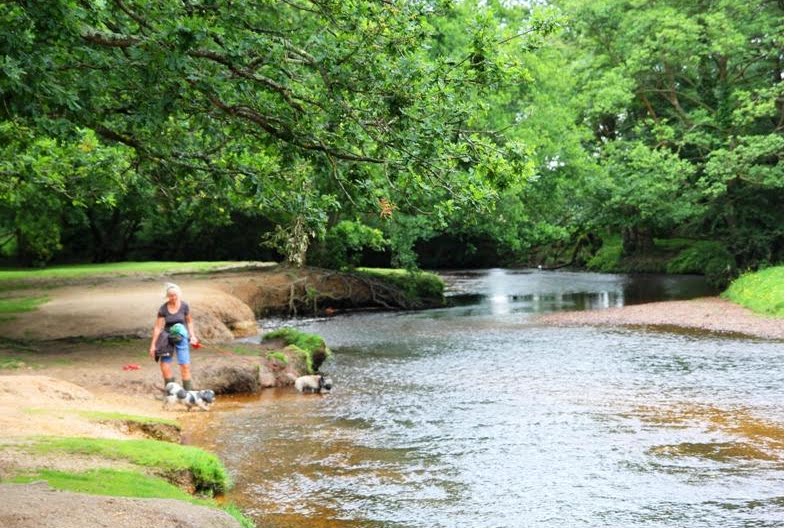
Cooling off after a morning outing
On the outskirts of the village, is the magnificent Brockenhurst College, red brick and covered with ivy, which could have formed the backdrop of Goodbye Mr Chips in that quintessential British schoolboy way. The whole area has that air of being 'well heeled' as many people from London have purchased homes in the area, and not always to the liking of the locals, well so I was told.
I drove on to Lymington on the coast where I presumed that the people were referred to as 'Limeys,' and not just by the Americans, but didn't have the temerity to inquire. Lymington, particularly the old part of the village around the harbor area, is wonderfully atmospheric, almost in a Cornish sort of way, with narrow cobbled streets full of overhead bunting, and shops with tiny frontages, even claims of smuggling. It caters well for tourists with lots of quaint eateries and coffee shops, with views across the tidal basin to the not very distant, Isle of Wight. It was market day and the stalls were up, centuries of like custom in their wake, and the air was full of the smell of cheese and pasties, the wheeling and squealing of overhead seagulls with an angry eye for any discarded scrap. Alas, my Stilton and Leek pasty was fully consumed, much to their chagrin, and I kept a weather eye open for any retaliatory 'bombing' run!
I drove to the village of Beaulieu through moors countryside, full of gorse and ponds, and ponies that looked fit to run a Melbourne Cup. Further along, the forest resumed its closeness and with the sun out, the shafts of dappled light through the trees, the oak, yew and silver birch, fairly tinkled like a tiny stream. And then, like the opening of a lift door, I was suddenly in Beaulieu.
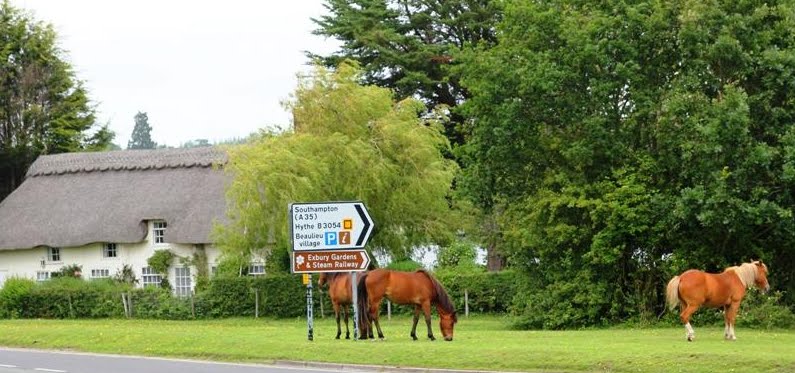
New Forest ponies graze by the roadside near a thatched cottage by the lake.
I explored first the village with its Georgian architecture and listed buildings, the working base for those who served Lord and Lady Montagu. I daresay some still do so serve the current Lord. The people I saw were all small and stooped, and the convenience store-keeper doubled as the postmistress when I purchased some postcards. "Oh the young crowd is at the Motor Museum," she said when I asked where the young people were. "They come over here under the sufferance of their parents. They all want to see the motors." We both nodded sagely and I bit my lip in what I hoped was an understanding gesture, and headed for the noise and the boys toys.
The National Motor Museum and the visit to Beaulieu Palace as well as the old ruined Abbey for which the Palace had once been the gate-house, all come on the one entry ticket, and is all extremely well organized. The gardens are exquisite and the Palace fronts on to broad lawns which sweep almost to a bend on the Beaulieu River where it forms a lake. I rode to the Palace on an old pre-WWI London bus, gleeful as a kid to climb the spiral staircase and sit at the very front of the open top deck, by myself. I noticed that there were long queues at the Monorail station, and that the patrons were mainly young. An old bus held little attraction for them I suppose, particularly as it went as fast as they did when they were eight or nine!
I alighted, as you do from an old bus, at the Palace and heard a roar of children's voices from a nearby annex. I noted it had been a 'training centre for SOE agents' in WWII. A silver-haired, beautifully groomed and clothed elderly lady with a name tag that said Susan, saw my look, glided over and whispered, "I suggest, Sir, that you do the Palace tour first, and come back here when the adolescents have gone. They hear about spying and James Bond, and they go all silly." I nodded my thanks, one oldie helping another, and she gave me a demure little knowing smile, conspirators we, together. That Bond fellow could sure learn a few things from us!
The Gothic style Palace, dating from 1204, has been partly opened to the public by the Montagu's and the rooms are quite exquisite in that they look stately but 'lived in,' with vaulted ceilings and elaborate formal dining settings, but also swanky spots around the piano, in comfy chairs, just right for eating a toasted sandwich. Each room had a be-costumed staff member, who looked as though they had come straight from Downton Abbey, and they all smiled dutifully and answered questions ever so politely.
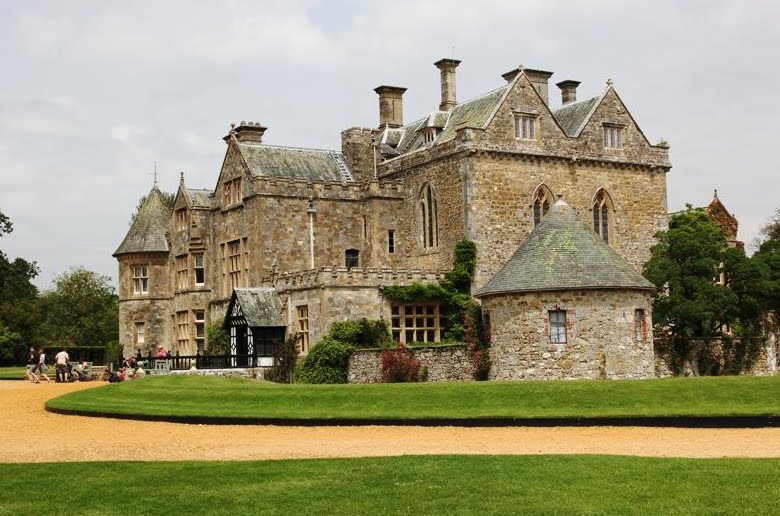
Beaulieu Palace dating from 1204 overlooks its own small lake.
My time had run away again, so I crept past Miss Silverlocks' annex, feeling sure she would miss me, and strode back through the beautiful gardens full of sculptures, to the Motor Museum. A throng of young dashed by me, anxious to get to the James Bond cars and gadgets exhibition, or maybe the Top Gear tent, which is also a 'feature attraction,' but I had others to see, and what was more, I could see them all on my own because they evoked little interest from the young. I looked at the old bangers and while they were of interest, they didn't hold me to their bosoms like some of my old memory motors did. My first car, a Morris 1000 with no synchromesh, huge steering wheel and a broad back seat, oh it took me back apace. There was a Mini and a Hillman Imp which had also played a role in my life, and a big humpback Standard Vanguard of the sort in which my brother slept in the front seat and me the back when my parents went to parties and came out periodically to give us a snack or check we were sleeping!
There are so many things that you associate with cars and the things you did 'back then,' and I took my time, wallowing in nostalgia in a manner that you can only do when you get older, and which drives kids to distraction at the mere mention of, "I remember when…" I gave the Ferraris and Rollers a cursory glance for they were simply beyond affinity, and certainly my means. But those old 'people's cars' drew me, the Bug, the "Lion Hearted" Anglia, the Triumph Herald, the Ford Cortina, and the Morris "It floats on fluid" 1100." Oh how true that was!
The time had come for my appointment with Mr Bond. I made my way to the special Bond in Motion section, past the great Grand Prix racers of Hill and Stewart, the land speed record holders, Seagrave's Golden Arrow, and Donald Campbell's Bluebird which had set the record at Lake Eyre in South Australia after weeks of waiting for suitable weather (once in a lifetime rain had flooded the salt lake), which had Campbell – and all Australians – in a tizz. There was so much to see and I cursed the time, briefly touching Bluebird as though it was some sort of totem, but I moved on.
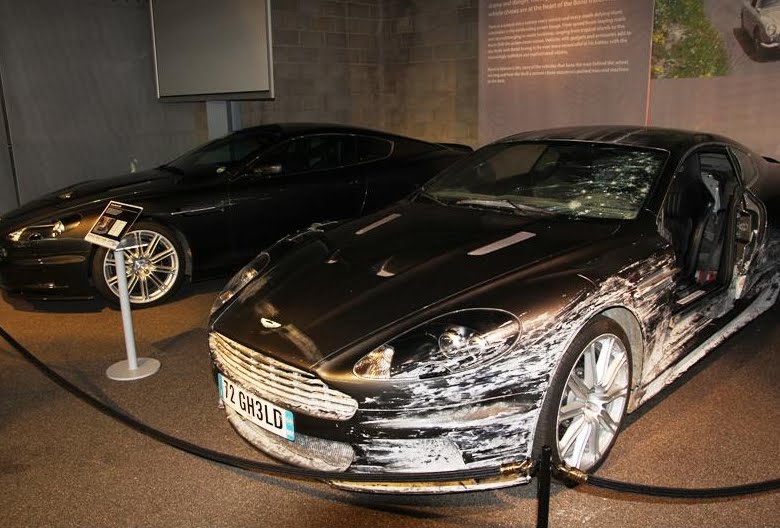
Shaken AND stirred, Mr Bond, requiring one thinks, a quantum of solace, hmmm!
Indeed, 'things Bond' are wonderfully represented in the Museum, jet skis, boats, the model of the 747 used in conjunction with a real 747 in Casino Royale, and all sorts of gadgetry that goes whizz, fizz, bang and pop. But it is the cars that draw the fans, and of course in that pantheon, the Aston Martins are kings. I recall that four or five DBS V-12's were used in A Quantum of Solace, and at least one was practically written off, while even the survivors looked bruised. The most famous, the DB5 from Goldfinger, Goldeneye and Casino Royale, with its pop-out machine guns, pop-up bullet shield, and its revolving number plates, is there too, as is Goldfinger's Rolls Royce Phantom III. I was unaware of the large number of cars associated with Bond films, but they are all listed at the Museum, from an Austin taxi through Audis, BMWs, Fords, GMs, Mercs to Range Rovers, Sunbeams and Triumphs, and I am quite surprised that the Zeta didn't get a run. It is a fun exhibition and for me it evoked some 'drive in' memories, of watching Sean Connery or suave Roger Moore, on a balmy night in Perth, Western Australia, with lots of honking and hooting during the stunts. They were movies that had it all, action, stunning locations, wry humour and quick quips, car chases and fights, bikini babes, and for the accompanying females, rugged hunks. Oh yes, at the drive in, everybody watched Bond flicks!
I briefly looked at the Cars of the Stars exhibit and went to the Top Gear tent and saw some of the show's most audacious 'experimental cars.' If you are a fan of the show, many are on display, the 'indestructible Hilux,' a racing motor-home, the airship caravan, stretched 'ordinary car' limos, boat cars, a cottage car, and you get a fair idea of the sort of fun they have making each program.

The old girl herself, the car that flew - Chitty, Chitty, Bang, Bang.
It was time to move on, but first I had to say goodbye to an old friend, the sound inspiration for me when as a uni student in 1968, I had to ride a little motor cycle, a real life little Chitty Chitty Bang Bang, and I marveled at the old car and imagined Dick Van Dyke at the wheel. And as I walked out the door, the words from the theme song came back to me;
Near, far, in our motor car, oh what happy time we'll spend,
Bang, Bang, Chitty, Chitty, Bang, Bang,
Our fine four fender friend.
Oh, all so true, our cars were our 'other' home on wheels, personified with names, patted for affection, cleaned, worked over and spruced, stolid supporters in our triumphs and in adversity, a refuge in inclement weathers, carrier of goods and a great, no, indispensable, travelling companion. Sometimes, just being in our car, was a nice place to be.
I had one last port of call, not far from Beaulieu, and that was Buckler's Hard, a C18 shipbuilding centre, with its strong association with Nelson's Navy, as three ships of his fleet at Trafalgar, were built there. It is a pretty little spot on the Beaulieu River, while the shipbuilders and artisans cottages have been well preserved and some are open for viewing. The nearby woods were vital to shipbuilding material in the C18 and C19, and an excellent little museum gives a marvelous outline of class and 'life back then,' the cramped conditions of the labourers, the spacious homes of the naval architects and shipwrights.
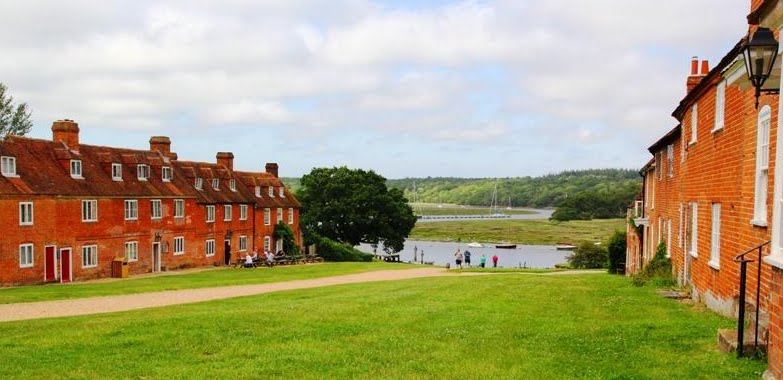
The C18th ship-building village of Buckler's Hard.
Buckler's Hard was also vital to the 1944 D-Day as huge sections of the Mulberry Harbour were built there, and hundreds of Landing Craft sailed from the Beaulieu River to support the Normandy landings. Buckler's also has strong links with the first yachtsman to solo-circumnavigate the world, Sir Francis Chichester, and the museum carries some of his personal items.
The museum also has a quirky little exhibition to a salvage operation on the P&O liner SS Persia which was sunk without warning by a German U-boat off the coast of Crete on 30 December 1915, killing 343 of her 519 passengers. The Persia was carrying a Maharajah's gold and jewelry, and when the wreck was found in 2003, at a depth of 3000 metres, it was the world's deepest salvage operation. While the team was able to get into the strong-room, only a few jewels were found, but the exhibition features cutlery and a few other items.
Oh, the connection? Well, the Persia had as a passenger, John Douglas Scott Montagu, Second Baron Montagu of Beaulieu, as well as Eleanor Thornton, his Secretary, and mistress. He was wearing a bespoke life-vest and was saved, and she went down with the ship. Interesting, but so what? Well, and here is the motoring connection to round off the story, and indeed this travel tale. Eleanor was the model for The Spirit of Ecstasy. Still I see you frowning! Well, The Spirit of Ecstasy mascot, a woman, arms behind her, garments as blown by the wind, has adorned every Rolls Royce since 1911, and there are quite a few Rollers in the National Motor Museum, where the mistress holds court.
"Ellie in a nighty," I hear you mimic the upper class toffs of the time. Is nothing sacred, you cad and bounder!
Winfred Peppinck is the Tales of the Traveling Editor for Wandering Educators.
All photos courtesy and copyright Winfred Peppinck
